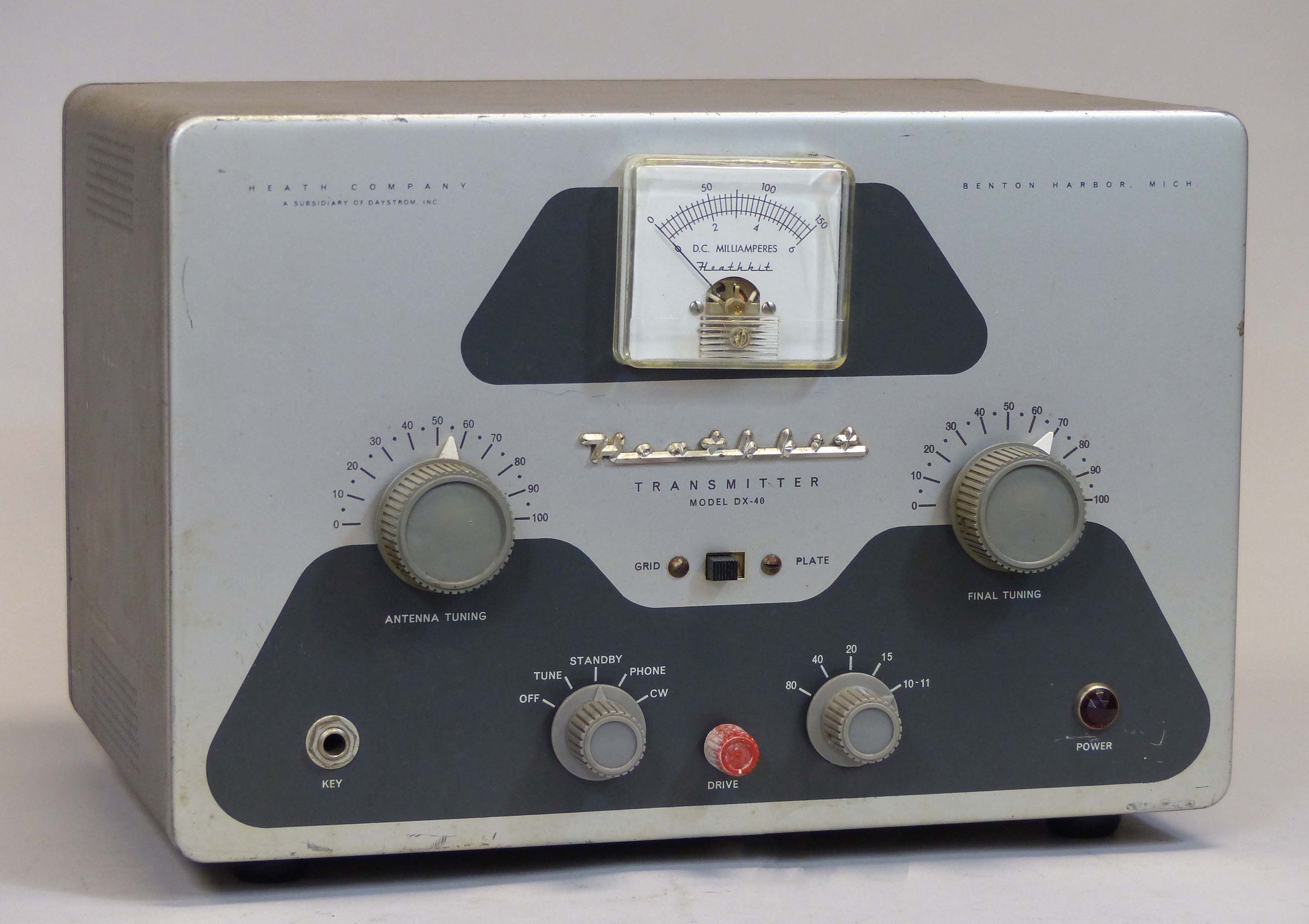Note
Released in time for Christmas in 1957. Outwardly, the DX-40 is almost identical to the DX-35. There are, however, two notable differences. The most obvious of these is the meter. The old iron-vane meter of the DX-35 has been replaced with a modern plastic cased D’Arsonval type. The D’Arsonval meter wobbled much less than the iron-vane type and made tuning easier and faster.
The other obvious change is in the function switch—it now has a “tune” position. The oscillator has been changed to a hot-cathode Colpitts type, and the unit employs cathode keying. Heath also took the opportunity to increase the output power a bit. The DX-40 runs 75 watts on CW and 60 watts on AM using screen modulation and has much better average modulation compared to the DX-35.
The 6CL6 buffer will tune second, third and fourth harmonics, so that a wide variety of crystal frequencies may be used. Even 160-meter crystals are satisfactory.
Two versions of the DX-40 were produced. The original version, with assembly manual part number 595-180 dated 12-16-1957; and a later version with same part number, but dated 6-29-59. In the second version, Heath made numerous changes, primarily to the audio circuits, but also to improve power distribution. The different versions can be identified by the 6146 plate choke, which is visible with a flashlight shining through right-side top cabinet ventilation holes. Refer to photos.
Particular attention should be paid to the knobs and the panel meter as these are often found to have been replaced with non-original parts. Also take care to note the presence and condition of the plastic Heath insignia under the meter, and that the meter has the Heathkit logo printed on the face. This silver colored insignia replaced the black version found on the DX-35.
The DX-40 was the last of the pre-classic DX-style of ham gear and was replaced in 1961 by the DX-60, which reflected a new, modernized design. Heath also made a British version of the DX-40 called the DX-40U. The DX-40U uses British tubes and a variety of components different from the American version.
Note: the crystal access door is the same one used for several Heath oscilloscopes including the O-10, 11 and 12, and the IO-12, 18 and 30.
Caution: When the transmitter is switched to either CW or PHONE operation, 120 VAC is present on pins 5 and 6 for operation of an external T/R relay. Because the mode switch breaks only one side of the line, pin 5 is always hot. A shock hazard exists.
Caution: Not fuse protected.
References:
Overview. Electric Radio. Apr 2002
Overview. Electric Radio. Oct 2018
Review: CQ, Mar 1958, p.68.
AF distortion. CQ. Apr 1961, p. 78.
TVI precautions. CQ. Jul 1961, p. 76.
AF gain. CQ. Jul 1961, p. 77.
Final modification. CQ. Aug 1961, p. 96.
Use with SB-10. 73 Amateur Radio. Feb 1963, p. 50.
Use on 6 meters. QST. Aug 1958, p.146.
Plate modulation. CQ. Dec 1960, p. 52.
Plate modulation. 73 Amateur Radio. Jul 1961, p. 39.
Use on 6 meters. CQ. Jan 1962, p. 74.
Plate modulation. CQ. Feb 1962, p. 83.
Use on 6 meters. CQ. Jun 1962, p. 32.
Modulation problems. CQ. Jan 1963, p. 74.
Use on 6 meters. CQ. Feb 1965, p. 87.
Intermittent operation (brief). CQ. Mar 1965, p. 67.
Output drops off after 1 min key down. CQ. Sep 1966, p. 90.
Blows fuses. CQ. Dec 1966, page 78
Spurious signals. CQ. Feb 1971, p. 64.
RFI on standby. CQ. Oct 1972, p. 12.
Revisiting. Electric Radio. Oct 2018.
AM improvements. Electric Radio. Nov 2018.
Power input: 75 watts CW, 60 watts peak controlled carrier phone
Output impedance: 50-1000Ω
Output coupling: Pi-network, SO-239
Band coverage: 80, 40, 20, 15, 11 and 10 meters
Power requirements: 120 VAC, 60 Hz, 175 watts
Tubes: (1) 5U4, (1) 12AX7, (1) 6DE7, (2) 6CL6, (1) 6146
Photos, general information and specifications from "Heathkit: A Guide to the Amateur Radio Products," by Chuck Penson, WA7ZZE. Used with permission.
